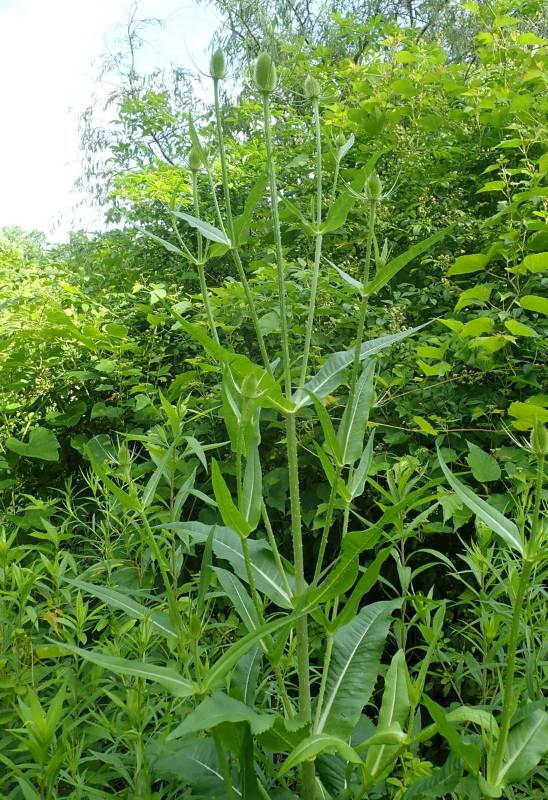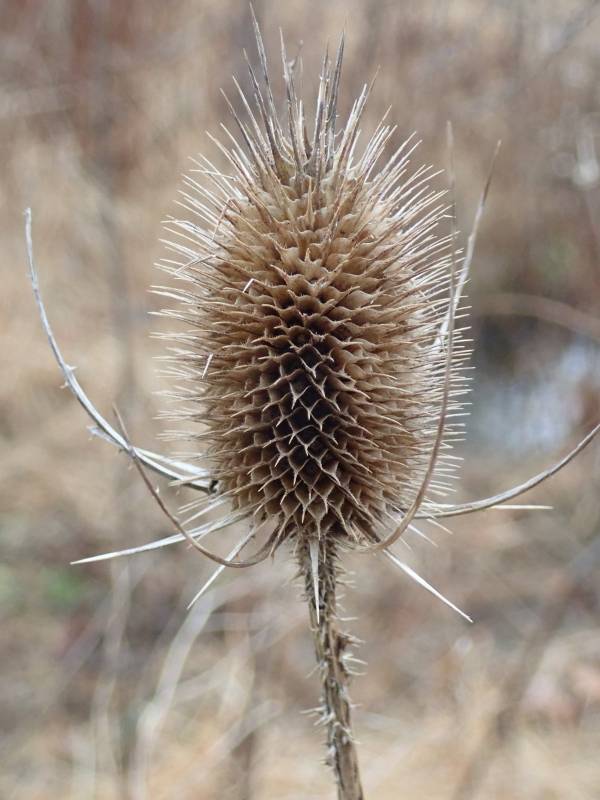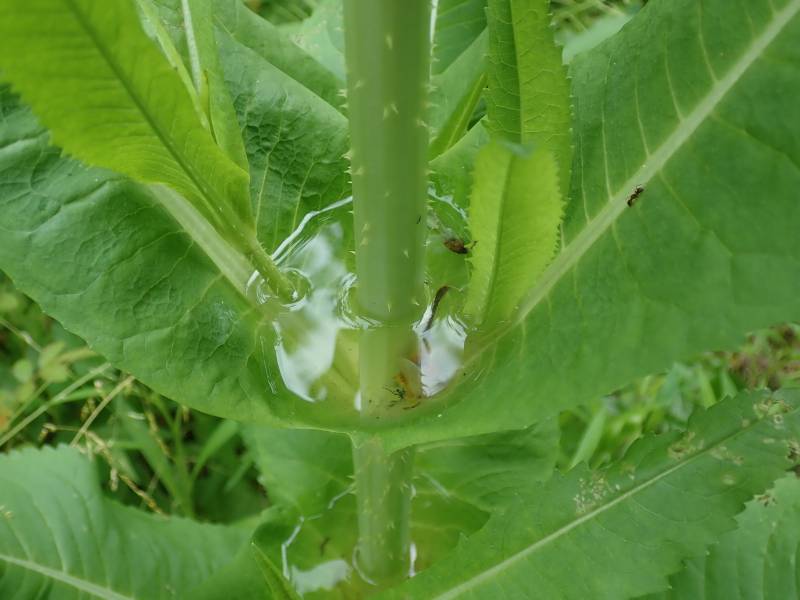Because the GNA is an isolated forest fragment in a 'sea' of development, the preserve is vulnerable to a wide range of threats: e.g., habitat fragmentation, overgrazing by deer, species loss from invasive plants, non-native insects and diseases, etc. Hence, GNA staff, along with WCU faculty and students are engaged in a variety of activities to help protect this irreplaceable resource.
Restoration & Reforestation
"I now suspect that just as a deer herd lives in mortal fear of its wolves, so does a mountain live in mortal fear of its deer. And perhaps with better cause, for while a buck pulled down by wolves can be replaced in two or three years, a range pulled down by too many deer may fail of replacement in as many decades."
— Aldo Leopold, A Sand County Almanac, 1949
Forest fragmentation, the killing-off of large predators, and conflicts over hunting have resulted in the proliferation of white-tailed deer to unprecedented population densities. It is estimated that the deer population at the GNA is on the order of 80 individuals (see: GNA Deer Management Plan ). Hence, the population density of deer is ~25-40 times the lands' 'carrying capacity' (i.e., the deer population that could be maintained without tree regeneration being significantly impacted).
At the GNA, deer density has been so high for so long that a 'browse line' is starkly evident throughout areas with mature forest and most species of tree seedlings are nearly absent from the forest floor. In particular, native oak seedlings, which are highly preferred food for deer, are now rarely found. Although there is regeneration of a few species that are less preferred by deer (e.g., American beech, white ash, and various hickories), the number of seedlings hardly seems adequate to replace the current canopy species in the future.
Beginning in 2008, GNA Staff, WCU Faculty, and countless student volunteers have planted a variety of trees in the GNA.
(To be continued — Check back soon)
Biochar Production
Biochar is a carbon-rich material that is produced through the pyrolysis1 of organic 'waste' materials. The char is then 'charged' with nutrients and inoculated with microbiota (see description below).
Beginning in the summer of 2021, GNA staff have been creating biochar with fallen wood from the Gordon.
A special kiln is used to create biochar, by efficiently burning wood at high temperatures where pyrolysis (thermochemical combustion without the presence of oxygen) occurs.
To feed the fire, layers of wood are gradually added to the kiln, after the previous layer has burned down and become completely charred.
GNA staff have recorded that each layer takes approximately 15-20 minutes to become completely charred and can burn up to 1200° C (~2200° F).
After hours of pyrolysis, the quenching process can begin to extinguish the flames. GNA staff will begin by quenching (adding water) to the bottom of the fire through a hose that can be connected to the kiln, then begin to gradually extinguish the fire from the top down.
Once the quenching process is finished the charcoal is soaked and let sit to completely cool down. GNA staff have coined this stage of creating biochar as “Charder” due to the charcoal's soupy appearance.
Once the charcoal has cooled and dried out it can then be crushed and ground to a finer consistency.
This process results in carbon rich charcoal that will then be supplemented with compost and nutrients that will enrich the biochar. Once this is complete the biochar will be ready to be used and added to help enrich soil in the Gordon and support native plants and vegetation.
— Nur Ritter & Maeve Dowd (GNA Student Intern)
1. Pyrolosis is a thermochemical process that decomposes biomass at elevated temperatures.
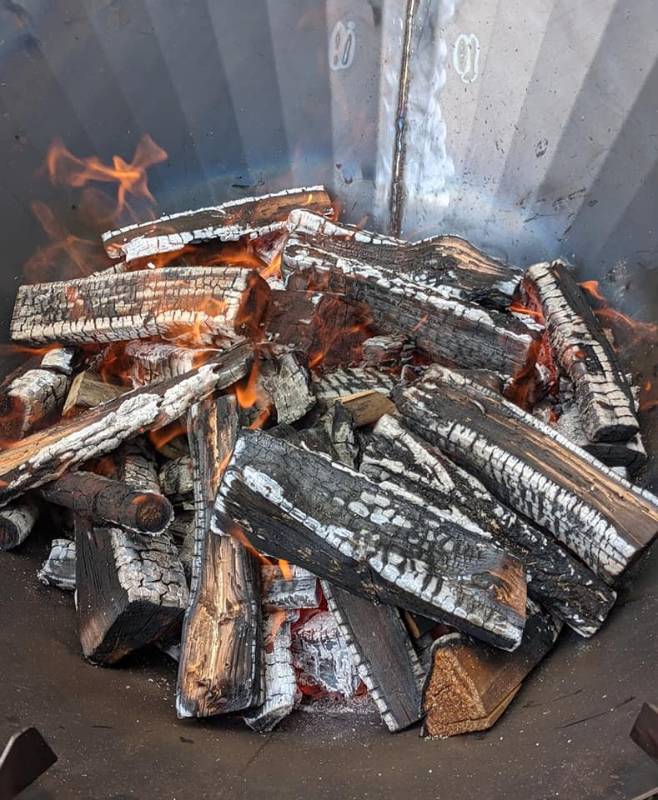
The 'mid-stages' of a burn. Once the largest portion of the top layer has a coating of ash (the white-gray portions in the photo), it's time to add another layer of fuel.
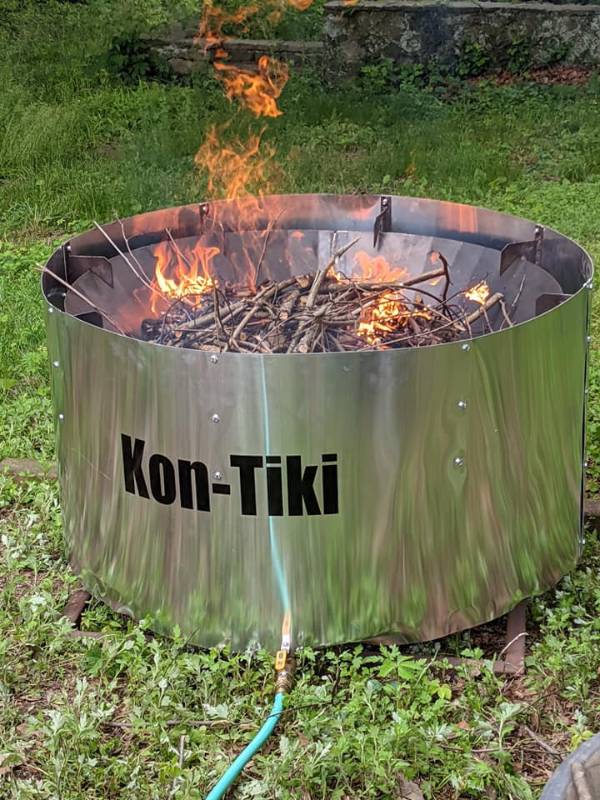
The Kon-Tiki biochar kiln during the end stages of a burn. The hose at the bottom of the image is bringing in water to the bottom of the kiln to quench the 'fire.'
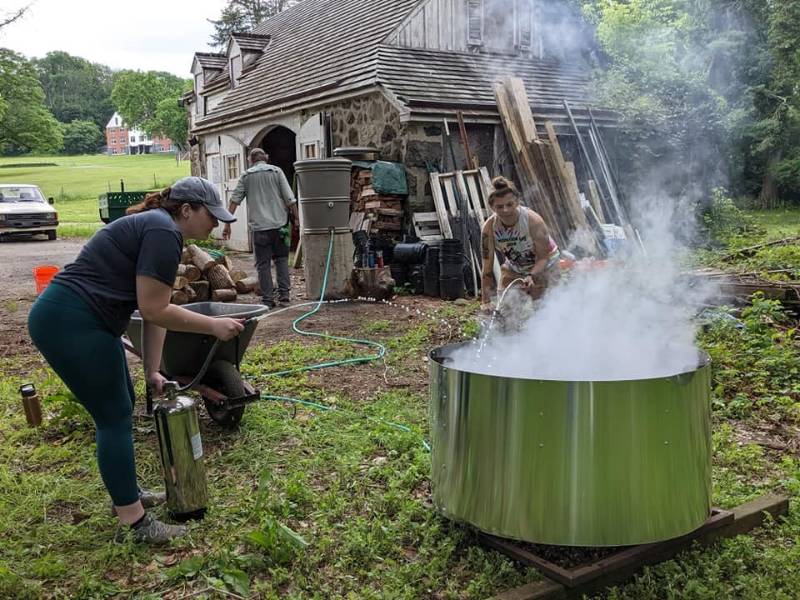
Student Interns Maeve Dowd (left) and Madison Rettnmaier 'top queching' the burn: the final step in the burn process.

The char after it's been quenched (aka 'charder')
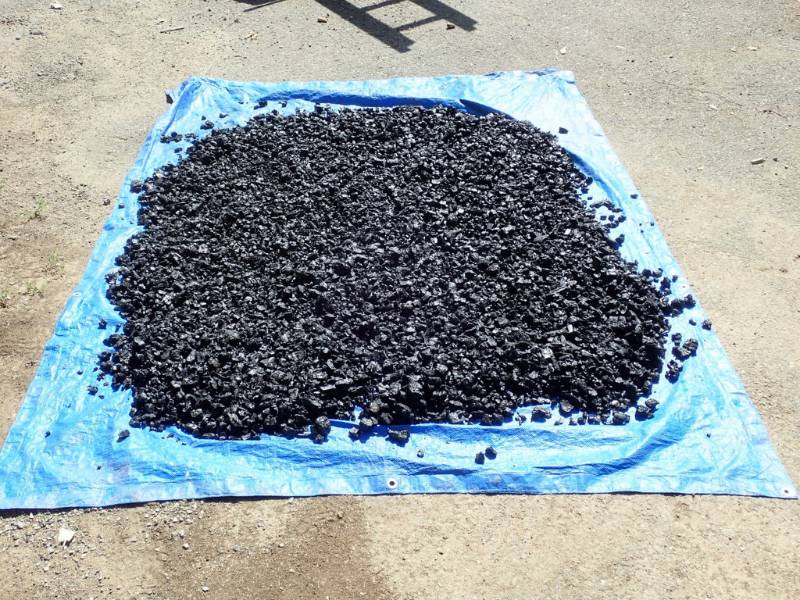
The char from a single burn drying on a top prior to being more finely ground
Native Plant Nursery
Overgrazing at the GNA has also had significant impacts on herbaceous species. Many of the herbaceous species that were formerly common at the GNA are now uncommon and their occurrences are scattered. Additionally, a good portion of the regions' spring ephemeral species are ant-dispersed, requiring us to compete with the ants (who are much more proficient at seed collecting).
To help address these issues, we've begun work on a native plant nursery at the GNA. Our intention is that the nursery will help us to increase seed stocks for species that we plan to incorporate in restoration efforts. In the fall of 2016, 8' high fencing was installed around a 50' x 35' area in a forested portion of the GNA. In the spring of 2017, we began installing raised beds and began transplanting a small number of native species.
Although we are doing some small-scale transplanting in the nursery's first year, we intend to primarily grow species from seed. Having 'centralized' populations of species will facilitate seed collection. In particular, having easy access to populations of ant-dispersed species will greatly aid us in accumulating stocks of these difficult-to-collect seeds.
The first three beds at the Native Plant Nursery.
Wild Plant Sanctuary
In 2014, the Gordon Natural Area was designated as a 'Wild Plant Sanctuary' by the Pennsylvania Department of Conservation and Natural Resources. You can read about the GNA's inclusion in that program here.
Since the initiation of monitoring in the mid-1980's, 431 native plant species have been noted in the GNA. Fifteen of these species are on the Pennsylvania Natural Heritage Program's (PNHP) list of plant species of conservation concern.
To help manage and protect these species, we have begun geo-referencing and mapping all occurrences that we encounter. Additionally, we have begun installing exclosures around species that are sensitive to browsing.
The image to the upper right shows an exclosure that was installed to protect a small population of the state-imperiled Nodding Trillium (Trillium cernuum). We installed the exclosure within a few days of encountering the population. Nevertheless, in the interim, two of the four individuals of Trillium at that site were browsed to the ground!
The image on the lower right shows the Crippled Cranefly Orchid (Tipularia discolor). This State-listed species is known from a couple of locations in the GNA. In the winter of 2016, we placed an exclosure around this small sub-population (just two individuals). In the summer of 2017, the orchid was observed in flower for the first time.
Invasive Species Control
Non-native Species
As noted, the Gordon Natural Area represents an isolated forest fragment situated within a heavily developed area. Not surprisingly, a significant portion of the flora is represented by non-native species.
Of the 609 species of vascular plants noted at the GNA, 178 species (~29% of the flora) are non-native. Forty-five (~25%) of these 178 species are listed as 'invasive plants' on the the Pennsylvania Department of Conservation and Natural Resources Invasive Plants List. Nine additional species are on the DCNR's invasive plants 'watch list.' The 'invasive status' of these 53 species is indicated on the Flora page.
In contrast to these aggressively invasive plants, many of the introduced species at the GNA are relatively benign (i.e., they don't tend to spread aggressively). Additionally, a number of the introduced species haven't been seen at the GNA for many years. For example, European Privet (Ligustrum vulgare), Scotch Pine (Pinus sylvestris), and Standish's Honeysuckle (Lonicera standishii), were all last observed in the GNA nearly forty years ago (all three were last noted in 1978), and six other introduced species were last observed in 1984. And, in at least a couple of cases, only a single individual of a particular introduced species is known for the GNA (e.g., the Goldenrain Tree, Koelreuteria paniculata, and the Sycamore Maple, Acer pseudoplatanus).
Despite many of the non-native species not being obvious threats, the GNA is home to numerous aggressively invasive plants, as is generally the case with forest fragments in urban areas.
Some of the more abundant and/or more problematic species at the GNA are:
Herbaceous Species
- Garlic Mustard (Aliaria petiolata)
- Lesser Celandine (Ranunculus ficaria)
- Japanese Stiltgrass (Microstegium vimineum)
Shrubs
- Amur Honeysuckle (Lonicera maackii)
- Japanese Barberry (Berberis thunbergii )
Trees
- Norway Maple (Acer platanoides)
- Tree of Heaven (Ailanthus altissima)
Vines/Climbers
- Mile-a-minute (Polygonum perfoliatum)
- Oriental Bittersweet (Celastrus orbiculatus)
- Porcelainberry (Ampelopsis brevipedunculata)
Invasive Species Control
Overview
As a suburban forest fragment with a significant amount of edge, the Gordon is extremely vulnerable to invasive species. Currently, 200 non-native plants are known to occur at the Gordon! Sixty-four of these are on the Department of Conservation and Natural Resources (DCNR) 'Invasive Plant List,' or fully half of the 132 species on the listed for the State.
Given the large number of non-native plants known for the Gordon, the ability of many of these species to quickly colonize areas, and the significant acreage that some of these species currently dominate (e.g., Garlic Mustard, Japanese Stiltgrass, and Lesser Celandine), approaches for controlling these species are problematic.
To date, the greatest portion of invasive species control efforts at the GNA have been directed towards controlling Garlic Mustard (Alliaria petiolata). Garlic Mustard was the focus of annual control efforts at the GNA from ca. 2009-2015 (see below). These activities incorporated a substantial amount of student labor. Unfortunately, it is unclear whether or not these efforts have had much success towards reducing this species' abundance.
Formerly, the invasive climber Mile-a-minute (Polygonum perfoliatum) was becoming abundant in some areas of the GNA. However, in 2009 the Gordon partnered with the University of Delaware to do an experimental release of the weevil, Rhinocominus latipes (a stem-feeding species that is an enemy of Mile-a-minute in it's native region). After the release of this bio-control, Mile-a-minute is noticeably less abundant in most areas of the GNA.
Invasive Species Early Detection and Response
An increasingly favored strategy at the Gordon is to focus on the early detection and treatment of invasives. Through this approach, we can hopefully eliminate, or at least control, recently established species before they become too widespread and/or abundant at the site.
One recently observed non-native is Teasel (Dipsacum fullonum; Dipsacaceae). A native to Europe that was brought to the U.S. in the mid-1700's, Teasel is not listed as an invasive plant by Pennsylvania. However, it is well adapted to wet conditions along roadsides and it appears that the national interstate highway system has facilitated its spread during the last half-century. The seed heads of Teasel are quite distinctive (see second photo below) and can be easily observed along roadsides in the West Chester area.
Although many sources categorize Teasel as being a biennial, it is more properly categorized as a 'monocarpic perennial,' i.e., a plant that is maintained in 'vegetative condition' (in Teasel's case, it's a rosette of leaves) until it has accumulated sufficient resources to flower and set seed, after which the plant dies. Under some conditions, flowering could occur by the second year (in which case, it would be functioning like a biennial), while under other conditions it can spend a longer time in rosette form.
The plant is also noteworthy for its perfoliate leaves: oppositely arrayed leaves that are fused around the stem, and which appear to have been 'pierced' by the stem (see third photo below). On larger stems, the lower pairs of leaves curve upwards forming a cup that can accumulate rainwater. We've observed numerous drowned invertebrates in these 'cups.'
Teasel was first observed in the Gordon in January of 2019, at which time a single clump of five individuals was noted south of Stadium Road in the wet meadow at the eastern end of the GNA. This portion of the meadow borders the ramp for Route 202 and there are a number of non-native species in this area that have likely been introduced through this roadway. We had hoped to begin control efforts in 2020, however, due to time limitations we decided to postpone that work until 2021. During 2020 surveys for Teasel, we found many individuals upslope from the original observed clump. And, in the course of surveying in the following year we found numerous additional occurrences, including many plants on the other (northern) side of Stadium Road.
This year, during the first week of June, we initiated effort to remove Teasel from the meadow. Through this work, GNA Student Interns Maeve Dowd and Noah Long removed 173 Teasel plants from the area. It should be noted that all our searches for this species have entailed only looking for the flowering (or, soon to be flowering) stems. There were likely many more plants that were in rosette form at the time of the surveys and which weren't detected. Nevertheless, as Teasel is said to average around 3,000 seeds per plant, Noah and Maeve's efforts have potentially eliminated at least half a million Teasel seeds from the meadow seedbank. The actual number of potential seeds likely far exceeds this estimate, as large plants can have up to 40 flowering heads (a single flowering head is said to average 850 seeds). Hence, a single, very large plant could have upwards of 34,000 seeds.
We plan to continue with these control efforts next year. Hopefully, we'll be able to search for Teasel rosettes in the early spring and will also be able to remove this portion of the Teasel population during next year's work.
Garlic mustard (Alliaria petiolata) growing on the GNA forest floor.
Lesser Celandine (Ranunculus ficaria) covering the GNA forest floor in early Spring.
Japanese Barberry (Berberis thunbergii) dominating an area of seasonally-inundated forest at the GNA.
Amur Honeysuckle (Lonicera maackii) dominating the forest floor. This species retains its leaves well after most other species have dropped all their leaves (the photo was taken in early December, 2016).
PIles of Garlic Mustard that were removed during one of the annual 'Garlic Mustard Pulls' at the GNA.
A large (based on the individuals at the GNA) stem of Teasel (Dipsacus fullonum)
The characteristic 'seedhead' of Teasel
The perfoliate stem and water-filled leaf bases of Teasel
Emerald Ash Borer Monitoring and Control
The Emerald Ash Borer (Agrilus planipennis) is an Asian insect that infects species of Ash (Fraxinus spp.). The EAB was first noted in the United States in 2002. Since that time, this species has become established throughout the eastern US, and hundreds of millions of ash trees have perished due to EAB infestation. To date, EAB has not been recorded for Chester County, although it has been found in four of the five adjoining counties.
If EAB does become established in the area, the prediction is dire, both for the GNA and for the remainder of the WCU campus. Infected trees generally die within four years following the initiation of infection. In a campus-wide census, 1,443 ash trees were noted in the GNA, with an additional 609 observed elsewhere on campus. Thus, an Emerald Ash Borer infestation would likely result in the death of significant numbers of trees on campus, resulting in the GNA and other areas being radically changed.
Hence, early detection of EAB has been accorded high priority in the GNA work plan. Kendra McMillin (a long-time GNA student intern and, subsequently, the Assistant Stewardship Manager at the GNA), instituted an EAB monitoring program at the GNA and on the WCU campus. Monitoring began in 2011 and is ongoing
Additionally, Kendra initiated a partnership with Pennsylvania's Department of Conservation and Natural Resources (DCNR). From this partnership, EAB biological control efforts were begun at the GNA in 2016, in an effort to help evaluate management strategies for EAB in Pennsylvania.
Biocontrol efforts in the Summer of 2016 consisted of releases of two insect species (Tetrastichus planipennisi and Oobius agrili) that are known to parasitize EAB in its native range. Twelve American Ash trees were selected to receive the two insect species. The insects were released weekly for eight weeks.
Biocontrol efforts in the Summer of 2017 consist of four rounds of releases of Tetrastichus planipennisi and Oobius agrili, and a single release of Spathius agrili (another EAB parasitoid). Additional parastitoid releases will be undertaken in the Summer of 2018. The releases in 2017 and 2018 will take place every three weeks, or so. Following the 2018 releases, GNA Staff will assist with the harvest and examination of the 'release' trees.
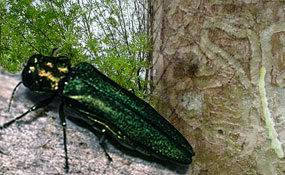
Adult Emerald Ash Borer

Kendra McMillin with former Summer Intern, Natalie Naylon, changing an EAB 'sticky trap'.
Trail Rehabilitation & Erosion Control
The GNA contains approximately three miles of trails. Of this, about half is composed of ‘unofficial trails’ (trails that are neither marked, nor maintained). Although not officially ‘sanctioned’, some of these trails get extremely high use, and are showing signs of wear. Additionally, some trails—in particular, those that parallel Plum Run, or those which run directly upslope are poorly situated with regard to erosion potential.
We have begun to address these issues on some trails by either closing the trails to foot traffic (hopefully), or by rebuilding the trail surfaces and adding erosion control structures to the more heavily-eroded sections of trails.
To date, trail closure has consisted of planting trees along the beginning and ending section of trails. The trees are protected with fairly large (i.e., ca. 3') diameter wire mesh exclosures in order to create an impediment to easy walking (see photo). Usage on the two trails on which trees were planted appears to be somewhat reduced. However, one trail, which runs alongside Plum Run, still receives a good deal of use.
In order to help inform visitors why we were closing the trails, we provided an explanation in the GNA Kiosk and installed a sign indicating why the trail was closed. There was some initial vandalism of some of the trees, and the sign was only in place for a few weeks before it was stolen, but people have generally been respectful of the changes to the trails.
Recently (August 2017), we purchased a 'LogRite Buck Arch' (see photo) to assist in moving logs and boulders into areas that are receiving erosion control structures. Logs are installed perpendicular to the flow of water in order to create a sediment dam. A series of logs are placed along the eroded section of the trail (or former trail) and, over time, sediment
Tree planting along one of the decommissioned trails.
The 'Trail Closed' sign that was placed at the beginning of this same trail.
GNA Student Intern, Alexandra Hodowanec, moving a log to a heavily-eroded area.
Tree Tenders Tool Library
For the past ten years, or so, GNA staff have 'curated' a Philadelphia Horticultural Society Tree Tenders® Tool Library. These tools are available to any groups doing 'revitalization' work (e.g., tree planting, community gardening, stream restoration, etc.). The library contains a wide range of hand tools such as shovels, mattocks (two sizes), wheelbarrows, digging bars (two sizes), post hole drivers, pruning loppers, hand pruners, soil cultivators, rakes, tampers, etc.
Group representatives can email us and arrange to pick up the tools from the WCU campus. Borrowers are responsible for returning all tools at an agreed-upon time and for ensuring that the tools are returned in as good a condition as when they were borrowed.
You can also find other Tree Tenders Tool Libraries on the Pennsylvania Horticultural Society's website at: https://phsonline.org/programs/tree-programs/for-current-tree-tenders (scroll to the bottom of the page to see the Tool Library Map).
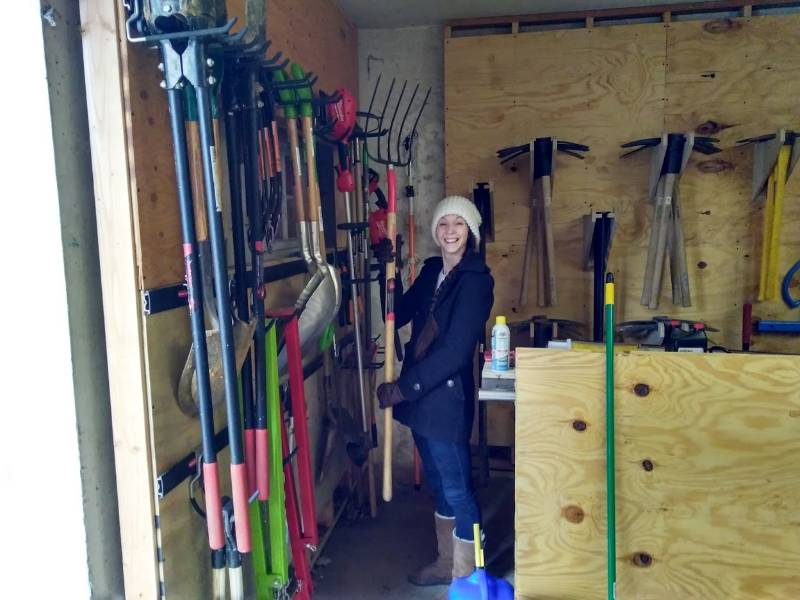
Monitoring
As was originally intended for the Gordon, the land has been the location for a lot of monitoring! The most 'significant' of these activities are described below.
"Plant life at the GNA has long held an attraction for both Faculty (beginning with Dr. Gordon) and students."
Vegetation Monitoring
Overlease Old Field Succession Study
From 1967 through 2000, WCU professor Dr. William Overlease and his wife, Edith Overlease, conducted annual monitoring on a series of sixteen 10 m x 10m plots in a portion of what became (in 1973) the Gordon Natural Area. The area in which the experiment plots were located was formerly a corn field.
In 2012, botanical consultant Janet Ebert and WCU undergrad Kendra McMillin ...
"Each year since 2009, Dr. Hertel (Department of Biology, Stewardship Manager for GNA) and Kendra McMillin (Biology Student) have re-measured the plots. In 2011, a contract botanist, Janet Ebert and Kendra McMillin conducted a survey in October, 2012, which was imported into Microsoft access database program and a CD was created and on Digital Commons. The data collected in 2012 was compared to the old data from Dr. Overlease and a final report was written by Kendra McMillin 2013."
Floristic Health Monitoring Study
In 2002, Dr. Gerry Hertel, the GNA's initial Stewardship Manager, acquired funding to initiate a long-term Floristic Health Monitoring (FHM) study of the Gordon. Procedures follow ...
Initially, 18 plots were installed at the GNA. An additional four plots were added for the second round of monitoring in 2008.
Site-wide Vegetation Surveys
There have been three site-wide floristic surveys of the GNA: during 1984 (by biology students Jack Holt and Jim Plyler); during 2007 by botanical consultants Jack Holt (the former student) and Janet Ebert; and during 2017-18 (an ongoing survey by Jack Holt and Janet Ebert). Because of this intensity of effort, vascular plants constitute the best-known biotic group at the GNA.
1984 Survey
2007 Survey
2017-18 Survey
Carbon Sequestration Monitoring
Currently, there are two ongoing studies by Dr. Joy Fritschle and Dr. Jessica Schedlbauer.
Publications and Presentations From Research at The GNA
Overlease, W. R. 1969. Early succession on abandoned cornfields in southern Chester County, Pennsylvania. Proceedings of the Pennsylvania Academy of Sciences 43: 101-105.
________. 1973. Observations on early plant succession in southern Chester County, PA. Proceedings of the Pennsylvania Academy of Sciences 47: 111-113.
________. 1973. The structure of selected deciduous forest in southern Chester County, Pennsylvania. Proceedings of the Pennsylvania Academy of Sciences 47: 181-197.
________. Checklist of the flora of Chester County, Pennsylvania. Bartonia 52: 60-77.
________. 1987. 150 years of vegetation change in Chester County, Pennsylvania. Bartonia 53: 1-12.
________. 2006. Some Notes on the Early History of the Robert B. Gordon Natural Area for Environmental Studies. Retrieved from http://digitalcommons.wcupa.edu/gna_wops_series/4. West Chester University, West Chester, PA. 2 pp.
________. and E. Overlease. 2011. Long-term observations of plant succession on an abandoned cornfield in southern Chester County, Pennsylvania (1967-2000). Bartonia 65: 97-104.

Undergrad Kelly Ryan estimating tree health as part of the FHM monitoring

Undergrad William Ricci estimating canopy height as part of the FHM monitoring

Students Kendra McMillin and Tim Ponticello monitoring the survival and growth of trees planted at the GNA
NOTE: This section of the GNA website is still a work in progress. Please check back as we continue to add content to the website.












